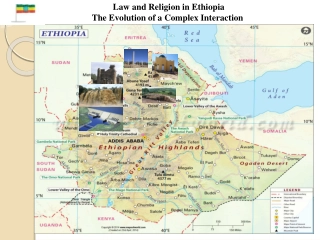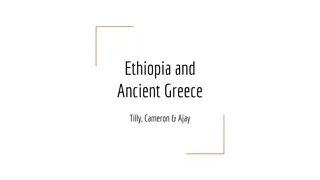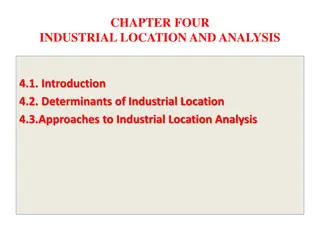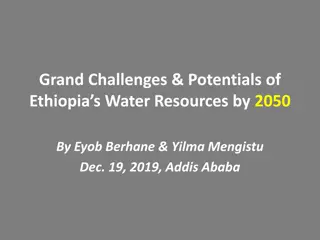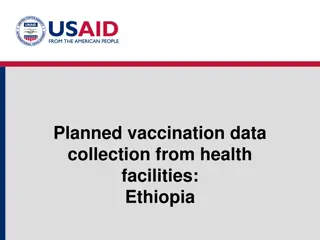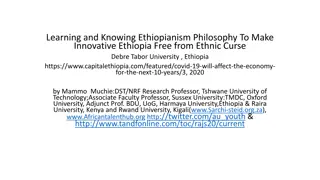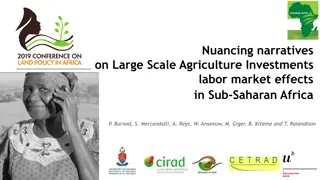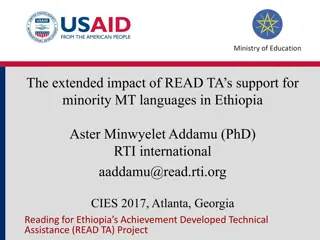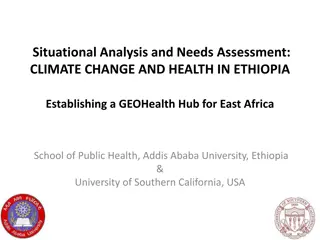Assessing Critical Dimensions of Indian Investments in Africa: A Case Study in Ethiopia
"This study focuses on Indian investments in Africa, specifically in Ethiopia's Gambella Region. It explores the potential for investment in various sectors in Ethiopia and highlights the country's investment climate, environmental and agricultural laws, as well as its international treaties and trade agreements. The analysis sheds light on the opportunities and challenges of investing in Ethiopia for Indian investors."
Download Presentation

Please find below an Image/Link to download the presentation.
The content on the website is provided AS IS for your information and personal use only. It may not be sold, licensed, or shared on other websites without obtaining consent from the author.If you encounter any issues during the download, it is possible that the publisher has removed the file from their server.
You are allowed to download the files provided on this website for personal or commercial use, subject to the condition that they are used lawfully. All files are the property of their respective owners.
The content on the website is provided AS IS for your information and personal use only. It may not be sold, licensed, or shared on other websites without obtaining consent from the author.
E N D
Presentation Transcript
Assessing the Critical Dimensions of Indian Investments in Africa (IIA) The case of Ruchi Soya Farm Gog Wereda, Gambella Region Ethiopia Tesfaye Getachew and Tewodros Yilma Lelena Global Consulting PLC, Addis Ababa, Ethiopia Sept 2014
Background Ethiopia - one of the fastest growing non-oil dependent countries in Africa. Promising potential for investment agriculture, agro-processing, textiles and garment, leather and leather products, tourism, mining and hydropower
National investment climate Ethiopia is centrally located within non-stop transport distance to all major markets, FDI flow to Ethiopia 54.4 billion birr in 2005 169.6 billion birr in 2007 and to more than 300 % growth in 2012. FDI - nearly acc for 85.5% of the total private investment projects (1991-2011).
Environmental and Agricultural laws /Acts Need for Environmental Impact Assessment & Authorization by Federal or regional EPAs Climate-Resilient Green Economy (CRGE) Strategy (2010) Protect the country from the adverse effects of climate change and to build a green economy that will help realise its ambition of reaching middle income status before 2025. Rural Land Administration and Use Expropriation of Land Holdings for the Public Forest Development, Conservation and Utilization Ethiopian Water Resource Management
International treaties and conventions Bilateral investment treaties (BIT) Ethiopia has bilateral investment and protection agreements with China, Denmark, Italy, Kuwait, Malaysia, Netherlands, Russia, Sudan, Switzerland, Tunisia, Turkey, Yemen, Spain, Algeria, Austria, UK, Belgium/Luxemburg, Libya, Egypt, Germany, Finland, India, and Equatorial Guinea Double taxation treaties (DTT Ethiopia has avoidance of double taxation treaties with fourteen countries, including Italy, Kuwait, Romania, Russia, Tunisia, Yemen, Israel, South Africa, Sudan and the UK
Investment and Trade Agreements Member of COMESA Under AGOA Ethiopian export products are entitled to duty-free and quota-free access to the United States market. Ethiopia is also a beneficiary of the Cotonou Agreement with the EU and is eligible for the Everything But Arms initiative, benefiting from the generalized system of preferences
National laws, rules and regulations governing foreign investment Commercial Registration and Business Licensing revised in 2010 : Commercial Code, 1960 revised in 2008: Expropriation of Land Holdings for Public Purposes and Payment of Compensation 55/2005: Trade Practice and Consumers Protection Proclamation 2010: National Social Protection Policy Of Ethiopia 2012:
Ethiopias major sources of FDI China, India, Germany, Italy, Saudi Arabia, Yemen, United Kingdom, Israel, Canada, and the United Arab Emirates The larger share of investments are in Afar,Amhara, Oromia, Gambella, SNNPR
Ethiopia-Indian relations Diplomatic relations -1948 Ambassadorial level -1952 Trade agreement signed in 1997 and set up a Joint Trade Committee that same year The volume of bilateral trade reached over US$ 500 million in2012 Ethiopia exports raw hides and skins, pulses, oil seeds, spices, and similar products to India. India, in turn, exports iron and steel products, drugs and pharmaceutical supplies, machinery and instruments to Ethiopia India initiated a Duty Free Tariff Preference Scheme designed to help Ethiopia and other developing African states export their products to India
Indian enterprises are largely concentrated in Gambella Karaturi Global is the largest investor in Gambellawith plans to farm palm oil, cereals, and pulses on 300,000 ha of land Ruchi Soya Acquired 25,000 ha and developed 3,500 ha and produces soybeans Verdanta Harvests Plc. : Acquired a 50-years lease for 5,000 ha in the Gambela region for a tea and spice plantation Sannati Agro Farm Enterprise Pvt. Ltd.: Ethiopia Acquired a 25-years lease on 10,000 ha in Dima District, Gambella Region, ChadhaAgro Plc. : Acquired up to 100,000 ha in Guji Zone in Oromia Regional State for a sugar development project Uttam Sucrotech : Won a $100-million contract to expand the Wonji-Shoa sugar factory
RUCHI SOYA INDUSRIES Incorporated in 1986 Manufacture of edible oils, vanaspati, bakery fats and soya foods. It is highest exporter of soya meal and lecithin from India Corporate social initiatives are executed through Shri Mahadeo Shahra Sukrat Trust Community collaboration (CSR initiatives) Education, health and women empowerment Vocational training courses RUCHI SOYA-Ethiopia Chosen Ethiopia considering the availability of labour, its strategic location and the Government support to boost foreign investment Signed a lease contract for 25-years Acquired 25,000 ha land in Gambella Region (892km west of AA) for production of soybeans Total investment capital 704,000,000 Birr (about 35,200,000 USD) Annual production capacity 100,000 MT palm oil, 10,000 MT palm kernel oil and 2,500,000 MT palm oil Cake
Assessment Results RESEARCH METHODOLOGY Research Questions Does Ruchi Farm, respect the interest of stakeholders and is responsive to needs of partners including communities? 1. Does the company protect and restore the environment? 2. Doest it promote inclusive development and respect human rights ? 3.
Data Collection and Analysis Data Collection Tools developed by CUTS International to adequately consider the NVG Principles on Social, Environmental & Economic Responsibilities of Business HH survey 2. Partner Interviews (KIIs) 3. FGDs 1. Limitations No data was collected from the Company
Data collection Data Analysis Quantitative data was collated and configured by Lelena Global staff using SPSS v15.0 software. The qualitative interview notes were transcribed into informational matrices on computers for each key informant interview and organized per NVG indicators and the information was later integrated with the quantitative analysis
Household survey Results HHs Profile 35 respondents 20 (57%) women Age ranges 30-39 (49 %) and 20-29 (31%). Most common HH size 4 (4.7 regional average) (94%) native to the same village and live in their own houses (rural huts) 88.5 % are unemployed Live on crop and livestock farming earning on average 200-300 Birr per Month
Social, Environmental and Economic Impacts of Ruchi soya Social 83% of the respondents said the presence of the company did not benefit the community No influx or migration due to the company Individual land use rights were not affected but communal land use rights are affected Forests were sources of firewood, wild food (fruits & roots), sources of medicinal plants, hunting grounds, wild animals left the place 66% of the respondents said they do not know whether the land acquisition process is a fair and a just process & another 34 % said the process is not fair All of the respondents said there no infrastructutre dev t effort they know by the company More than 57 % of the respondents said, either the company did not create job opportunities for women or they do not know if the company created job opportunities for women. All of the respondents reported the company did not attempt to run any skill development program The general feelings were, they could have negotiated on the community interests if were part of the process like land acquisition and would like to be part of it in the future.
Impacts Environmental Economic All of the HHs said there is big impact on forests high deforestation All the respondents said they do not realize company has no impact on water & air quality, diseases and land pollution 74 % of HHs said the increase in community s employment opportunities are insignificant 54%) of the respondents felt there is no increase in income of the community All reported no action by the company to restore the environment
Key Findings Individual land size and use right is not affected, but communal land use right diminished Clearing forests impacted food sources and diversity, restricted fuel wood collection area and resulted in migration of wild life Displacement and migration due to acquisition of land by the farm is not a major phenomenon to communities in Gog woredaas such; Land Transfer needs representation all concerned but in this particular case regional Agri was not part so not closely working with the farm and monitoring it adequately to ensure the adherence to the contractual obligations and to the environmental responsibilities Similarly the weredaconcerned agencies including the agricultural offices have not gone far as they couldn t solicit the support of the regional and Zonal agencies and also the farm cooperation. Contributions of the farm to the land, air and water pollution are not visible at this stage. However, continuous use of pesticides, herbicides and overuse of machinery will result in air pollution and will ultimately harm the environment
Key Ruchi Farm is not investing in human and physical environment development in its operational area so far. Provision of social services like schooling, health posts, clean water, construction of access roads and grain mils are all development priorities at the community and regional levels. Introduction of improved products and technologies like improved farming practices which are important to promote the wellbeing of the communities are highly needed, These all provide an opportunity for Rouchi to involve in as socially responsible company and strengthen its partnership with the community and local authorities and stakeholders at large Livelihood options created by the farm for the community are not significant as the farm provides only few employment opportunities to the surrounding community members as well as for distant communities.
Key The manpower needs are not filled by the local staff There hasn t been any promotional material printed or electronic broadcasted either by the company or form the government side to promote the investment Ruchi is not benefiting from a membership a chamber to introduce its business to the country, network with wide business companies in Ethiopia and in participating in the ongoing public-private dialogue All the evidences indicate that there is a long way for the company to improve its visibility as well as to show its social responsibility commitment which is vital in its marketing effort as a subsidiary of global company.
Recommendations Design/adopt/adapt and present a CSR strategy and present to the partners to show its acts are sustainable as well as responsible. As the assessment indicates that the farm is poorly connected to any partners in its operation area, it is imperative to identify the important partners around the farm operation area with the view of working together in areas of common interest particularly related with CSR attributes. Design a strategy to make the farm activities environment friendly and greener as well as community and employees centred to minimize and prevent the adverse effects of the investment related with deforestation, use of chemicals and heavy farm and construction machinery. The farm needs to manage and protect the environment/natural resources through initiating plantation schemes to replace the trees cut and maintaining the biodiversity of plants, reduce use of artificial chemicals and introduce environmentally friendly crop protection methods like biological control
Recomm key social infrastructure such as schools, health and sanitation facilities, roads, grain mills are lacking. The farm can work with the local government structure to identify and confirm the priority CSR activities and contribute to the provision such facilities and services. The different government agencies and the community needs to involve collaboratively and share information and responsibilities in land allocations and transfer and provide regulatory services so that investors are adequately facilitated in their business while at the same time be encouraged to discharge their responsibilities particularly CSR. Ruchi Soya needs to get the buy in of its project by the community by interacting and communicating more with them on the current and future benefits of the investment to the day to day life of the community by way of expanded employment opportunities, technology and skill transfers, and triggering key services relevant to the community. It is advisable for the company to take steps to be more transparent about their policies, commitments, product & services and associated operations, spending plan and annually report these both in the country and in India. It is also important to consider membership with the appropriate business association such as Addis Ababa chamber of commerce and sectoral association to be networked with companies working in the country and to be more familiar with the business law of the country.


